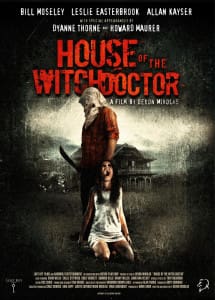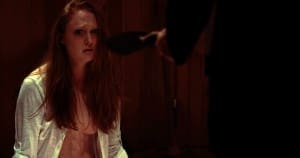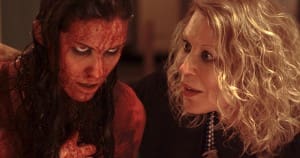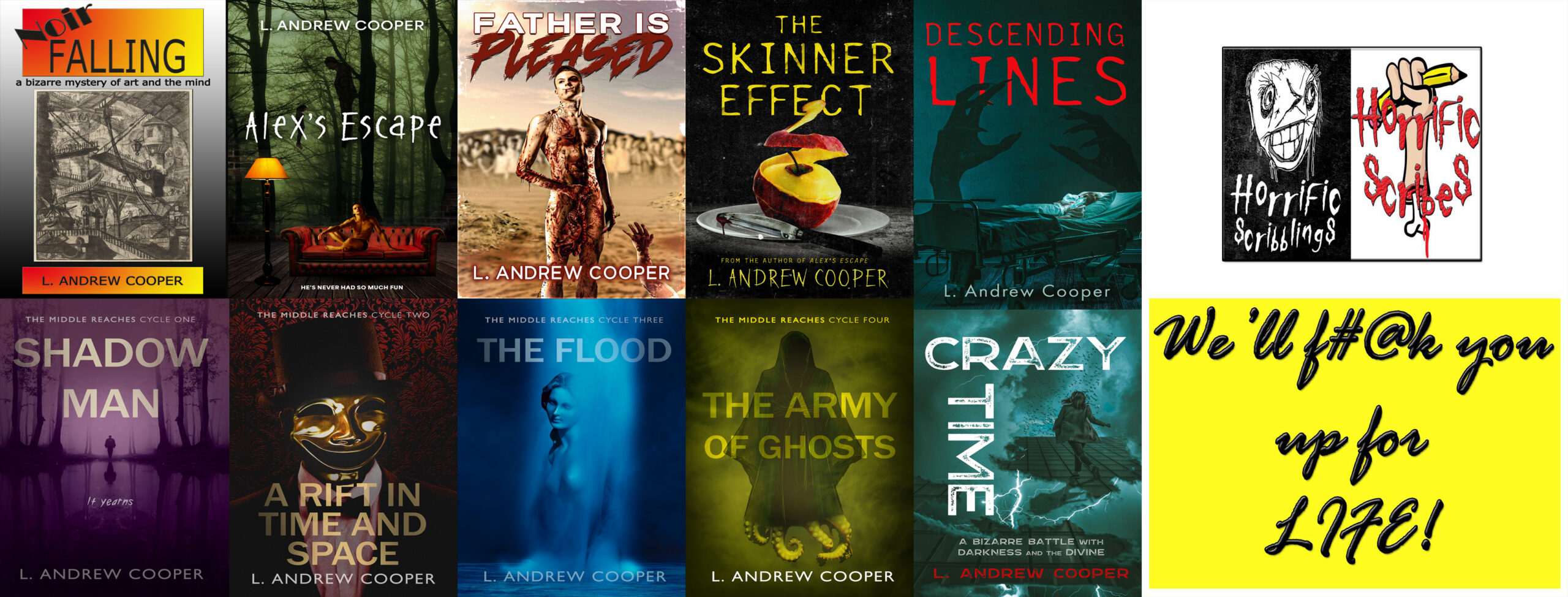Opening scene: stalk-and-kill, slasher with a bag on his head, victim unusually male but just as doomed, his dashing through the woods well-choreographed but familiar, his death a suitable intro for a scenario involving a group of attractive graduate students weekending at an isolated estate a year later to mourn him. But wait–this movie is called House of the Witchdoctor (2013/2014). That title has two genre cues, “House of” and “Witchdoctor,” and neither one signals a typical slasher.
 Nobody in the audience with me at Days of the Dead Indianapolis in June 2014 was likely surprised that Devon Mikolas’s debut feature takes twists. The title and opening sequence more or less promise twists by mixing genre cues. Furthermore, as Mr. Mikolas and I discuss in our guest interview, the title echoes Ti West’s vaunted House of the Devil (2009), which plays a similar game of slasher nostalgia and genre misdirection. While I like West’s film and was rather impressed by the support he showed the horror community during a personal appearance at the Chicago International Film Festival in 2013, I often think his film gets too much credit for innovative genre-mixing (credit I would more likely give to Rodriguez/Tarantino’s Grindhouse, 2007, or Eli Roth’s Cabin Fever, 2002, or just go back to the grindhouse master Lucio Fulci, The Beyond, 1981, and the game is off).
Nobody in the audience with me at Days of the Dead Indianapolis in June 2014 was likely surprised that Devon Mikolas’s debut feature takes twists. The title and opening sequence more or less promise twists by mixing genre cues. Furthermore, as Mr. Mikolas and I discuss in our guest interview, the title echoes Ti West’s vaunted House of the Devil (2009), which plays a similar game of slasher nostalgia and genre misdirection. While I like West’s film and was rather impressed by the support he showed the horror community during a personal appearance at the Chicago International Film Festival in 2013, I often think his film gets too much credit for innovative genre-mixing (credit I would more likely give to Rodriguez/Tarantino’s Grindhouse, 2007, or Eli Roth’s Cabin Fever, 2002, or just go back to the grindhouse master Lucio Fulci, The Beyond, 1981, and the game is off).
 I indulge in this little historical detour because I’ve read at least one review that claims House of the Witchdoctor suffers in comparison to West’s film, and I disagree. Mikolas has given us a horrific Frankenstein-monster of a movie, combining not a compendium of genre elements in a postmodern grab-bag of references, as was the way of 90s horror, but producing a new creature by selecting carefully from bodies that have come before. The bodies Mikolas selects are more numerous and, in the end, rather different from the bodies in West’s film. Together with a slasher closest initially to Friday the 13th Part 2 (1982, as opposed to West’s preference for Halloween, 1978,and When a Stranger Calls, 1979), it stitches a home invasion plot–getting a little more contemporary, hinting at The Strangers (2008) and Funny Games (1997 / 2007), but really harkening back to Last HOUSE on the Left (1972), which itself has roots in the mysticism of The Virgin Spring (1960). Mikolas’s home invasion body part, then, is deceptive in its connections to the various houses of haunting and hunting throughout history, and it threads together more readily with the supernatural hints of the title’s final word than would initially appear.
I indulge in this little historical detour because I’ve read at least one review that claims House of the Witchdoctor suffers in comparison to West’s film, and I disagree. Mikolas has given us a horrific Frankenstein-monster of a movie, combining not a compendium of genre elements in a postmodern grab-bag of references, as was the way of 90s horror, but producing a new creature by selecting carefully from bodies that have come before. The bodies Mikolas selects are more numerous and, in the end, rather different from the bodies in West’s film. Together with a slasher closest initially to Friday the 13th Part 2 (1982, as opposed to West’s preference for Halloween, 1978,and When a Stranger Calls, 1979), it stitches a home invasion plot–getting a little more contemporary, hinting at The Strangers (2008) and Funny Games (1997 / 2007), but really harkening back to Last HOUSE on the Left (1972), which itself has roots in the mysticism of The Virgin Spring (1960). Mikolas’s home invasion body part, then, is deceptive in its connections to the various houses of haunting and hunting throughout history, and it threads together more readily with the supernatural hints of the title’s final word than would initially appear.
I won’t give away the other, potentially supernatural body parts (doesn’t that opening run through the woods look a little like Suspiria, 1977, or am I imagining things?), but needless to say, the rest of the title is WITCHDOCTOR. That has to mean something, doesn’t it? It certainly means opportunities for some extra-creepy imagery.
 Telling you what happens in the film isn’t all that important, because predictability versus unpredictability isn’t the way to approach viewing House of the Witchdoctor. To be perfectly honest, I pretty much had it figured out from the beginning–so some of you won’t like it if you expect a twisty movie to outsmart you–but I really didn’t care. In fact, having a strong sense of where the film would take me made it much more interesting, as by providing strong hints of its endpoint, House of the Witchdoctor made me play a silent game: “Okay, Mr. Movie, so how are you going to get me there?”
Telling you what happens in the film isn’t all that important, because predictability versus unpredictability isn’t the way to approach viewing House of the Witchdoctor. To be perfectly honest, I pretty much had it figured out from the beginning–so some of you won’t like it if you expect a twisty movie to outsmart you–but I really didn’t care. In fact, having a strong sense of where the film would take me made it much more interesting, as by providing strong hints of its endpoint, House of the Witchdoctor made me play a silent game: “Okay, Mr. Movie, so how are you going to get me there?”
I found Mr. Movie’s, and since he’s both writer and director, it’s mostly Mr. Mikolas’s, answer highly satisfying, both visually and narratively. The appearances of horror veterans Leslie Easterbrook and Allan Kayser are special perks, and the comic turn by Bill Moseley is delicious. House of the Witchdoctor is a September 16, 2014 release from Breaking Glass Pictures on DVD (wherever you can get good ones) and VOD (iTunes, Comcast, Vubiquity). If you like imaginative blends of favorite horror motifs, you should definitely check it out.

Comments are closed.